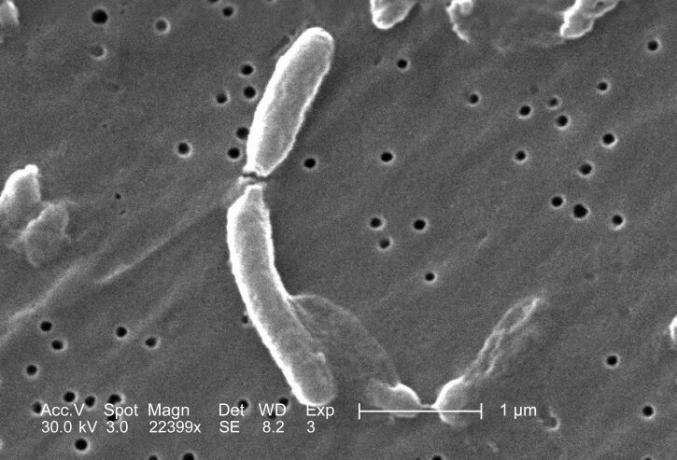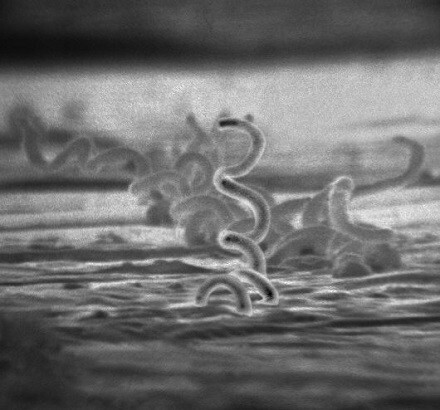Eubacteria: what are they, characteristics and types
We do not see them, but we are surrounded by them. They come in all forms and, although very small in size, they contribute enormously to our world being the way it is today.
Eubacteria are microorganisms present in most ecosystems on Earth and that can have from beneficial functions for our species to be even harmful, causing us disease and damage organic.
Then we are going to delve into the domain of eubacteria, also known as true bacteria, and we are going to discover how they reproduce, what forms they can take and groups there are.
- Related article: "The 4 types of pathogens (and their characteristics)"
What are eubacteria?
Eubacteria are single-celled prokaryotic organisms. These microorganisms are known as true bacteria or simply as bacteria and their domain is one of the three domains of life proposed according to the current evolutionary model., along with the Eukarya and the Archaea.
Until relatively recently, the term "bacteria" was used interchangeably to refer to all prokaryotic and unicellular organisms, but over time this domain was divided into that of eubacteria (Eubacteria) and archaebacteria (Archaebacteria), later being renamed as bacteria and archaeas (Archaea)
Being prokaryotic organisms (without a cell nucleus), these organisms are relatively simple, having their genetic material scattered throughout the cell matrix. But despite their simplicity, they are also one of the most abundant living organisms in nature, being found in practically any ecosystem on the planet. They inhabit any medium: soil, water, air and also on biotic and abiotic surfaces.
More than 5,000 different species of true bacteria have been described, which is why many are the scientific biologists and bacteriologists who consider that eubacteria are among the most common organisms in the nature. There are all kinds of them, also being pathogenic species, that is, that cause diseases in other living beings, although most eubacteria are harmless and even beneficial for the rest of life.
- You may be interested in: "The 12 differences between eukaryotic cell and prokaryotic cell"
Characteristics of eubacteria
As we have mentioned, eubacteria or true bacteria are very simple, unicellular and prokaryotic organisms. One of its main characteristics is the lack of a membranous nucleus in which its DNA is enclosed., or any other membranous cytosolic organelle. Added to this, we can highlight other very interesting characteristics of eubacteria.
The first is that, apart from being prokaryotic, they have a cell membrane made up of a double lipid layer, as happens in eukaryotic cells or cells with a nucleus. In the case of eubacteria, This lipid bilayer encloses a watery interior, known as the cytosol, where the genetic material of the cell is found and, among them, also cellular proteins such as, for example, ribosomes to be able to translate proteins.
Eubacteria are covered by a wall for protection, which is made up of a polymer called peptidoglycan. This polymer is composed of repeating residues of the carbohydrate N-acetyl-glucosamine and N-acetylmuramic acid, linked by β-1,4 bonds. In some cases, the bacteria present on their surface protein structures in the form of a filament that allows them to move known as cilia (if they are short and many) or flagella (if they are long and scarce).
The genetic material of prokaryotic cells is found in a specialized region of the cytosol known as the nucleoid. since, despite not being a well-defined kernel, it does more or less the same functions. Eubacteria have all of their genetic material collected on a single circular-shaped chromosome. Added to this, in the cytosol we can also find other extrachromosomal DNA fragments, called plasmids, which can be shared with other bacteria through a structure called pilus and generally carry metabolic information Useful.
In many cases, eubacteria are surrounded by a capsule or gelatinous matrix known as a glycocalyx.. It is a component rich in carbohydrates that protrude from the cell membrane and wall, the which provide a certain resistance against adverse environmental conditions, pathogens and antibiotics
Some eubacteria can transform into endospores when faced with extreme environmental situations. These are structures of resistance that help them to tolerate factors such as extreme temperatures, pH levels that are too acidic or too basic, excessive radiation... In fact, It is thanks to their ability to become endospores that they can survive in almost any part of the planet, on any type of surface and feeding on any thing.
Size and shape
Bacteria are miniscule in size but they can range from approximately 0.2 to 50 microns, although the average size is between 1 and 3 µm. Its shape varies greatly from species to species, the following three being the most common.
1. Coconuts
Cocci are spherical or ovoid cells, which are usually found individually or spatially ordered, depending on the plane in which they have been divided since sometimes they can remain together even after having been divided. They can be found in pairs, chains or numerous groups depending on the species.

2. Rods or bacilli
The rods or bacilli are solitary or united cells. Given their rod-like shape, these cells resemble those of a sausage. or a chorizo in case they are in a group.

3. Spirils
Spirits they are spiral-shaped bacteria as the name suggests, generally flexible.

Types of bacteria
At present, the most accepted classification for the domain of bacteria consists of the following 5 phyla.
1. Proteobacteria
Proteobacteria make up one of the most widespread, abundant and diverse groups among microorganisms. To this edge belong many bacteria with pathogenic capacity for humans and other species of the animal kingdom, being in this group the genera Salmonella, Helicobacter, Escherichia, Neisseria, Vibrio ...
One of the characteristics that stand out in proteobacteria is that they cannot be stained using the Gram method, which is why they are known as Gram negative bacteria. These microorganisms are divided into the following groups:
- ε-Proteobacteria
- δ-Proteobacteria
- α-Proteobacteria
- β-Proteobacteria
- γ-Proteobacteria
2. Spirochaetae
Spirochetes are spiral-shaped bacteria that can be very long, up to 500 µm long. Many of them are free-living microorganisms present in fresh or salt water, bodies of water rich in organic matter. Some of them are pathogenic for mammals, as is the case with Leptospira bacteria.
3. Chlamydiae
Chlamydial bacteria are generally intracellular parasites and this phylum is composed of only a single class (Chlamydia). In turn, this group is divided into two orders known as Chlamydiales, with 4 families; and Parachlamydiales, with 6.
4. Cyanobacteria
Cyanobacteria were once known as blue-green algae, or rather cyan in color as their name suggests. They are photoautotrophic, free-living bacteria or endosymbionts.
5. Gram positive bacteria
Finally we have the case of Gram positive bacteria, whose name means that they can be stained by the Gram stain method, invented by the Danish bacteriologist Hans Christian Gram (1853-1938). Within this edge we find:
- Firmicutes: endospore-producing bacteria. Used for industrial purposes.
- Actinobacteria: used for the bioremediation of contaminated waters and soils.
- Mycoplasma: includes pathogenic bacteria residing in mucosa and epithelia.
Nutrition of eubacteria
Within the domain of bacteria we can find both heterotrophic and autotrophic organisms. Heterotrophic bacteria are those that need to obtain their food from external sources, as in the animal kingdom, while autotrophs are capable of producing their own food from inorganic compounds, just like plants do.
Most heterotrophic bacteria are saprophytic, which means that they feed on dead or decaying organic matter. In other cases we find parasitic bacteria, that is, they live inside or outside another organism, causing it some kind of detriment. We also find the case of symbiotic bacteria which establish a mutually supportive relationship with another organism., giving them some benefit while receiving food in return.
In the case of autotrophic eubacteria we can find photosynthetic or chemosynthetic, which may or may not depend on the presence of oxygen. In the case of photosynthetics, these produce organic substances through photosynthesis using the energy that the sun's rays give them. and making different types of photosynthetic pigments work, such as chlorophyll. In the case of chemosynthetic bacteria, they use inorganic compounds such as ammonium, molecular hydrogen, iron or sulfur to produce their organic molecules.
Reproduction
Generally, true bacteria reproduce by binary fission, an asexual reproduction mechanism typical of prokaryotes and other single-celled organisms. As its name suggests, in this process two identical cells are formed from the fission of a progenitor or stem cell. Binary fission is a very fast reproductive mechanism, although the time varies depending on the species of bacteria, with some that divide in less than 20 minutes and others that take several hours.
The process begins with the duplication of the genetic material, that is, the bacterial chromosome in a circular way.. Immediately afterwards, the progenitor cell begins to increase in size and, moments later, the chromosome creates a copy of itself, migrating one towards one pole of the cell and the other towards the other. At this point, the cell has almost doubled its original size.
Inside the bacterium, a series of proteins begin to be activated, which are responsible for forming a division ring of the two daughter cells., locating more or less in the middle of the stem cell. In the region where this dividing ring has formed, a new transverse cell wall begins to be synthesized, which ends separating the two chromosomes located at each pole of the cell and causing the separation of the two daughter cells to occur identical.
Depending on the orientation in which the duplicated chromosomes are distributed, we speak of different types of binary fission (longitudinal, transverse or irregular) but in all of them the same events that we have mentioned.
The importance of these microorganisms
True bacteria make the world the way it is today, plus can be used for economic benefit. For example, these microorganisms participate in the cycling of nutrients such as phosphorus, sulfur, carbon and nitrogen, decomposing organic matter producing these nutrients as a residue from their action. In the case of photosynthetic bacteria, they use solar energy to synthesize organic compounds and release oxygen into the atmosphere, as plants do.
We have bacteria inside us, but they are good. Some species act as symbionts in the gastrointestinal system of many animals, including humans and many ruminant herbivores, participating in digestion. Within these we can highlight the Lactobacillus acidophilus and the Streptococcus thermophilus.
In the field of biomedical research, bacteria are often used as model organisms for the study of various phenomena on life and are also exploited to produce different biotechnological compounds useful for humanity. Without the bacteria, it would not be possible to have foods such as cheese or yogurt, nor drugs such as insulin, obtained through a transgenic strain of the Escherichia coli.

